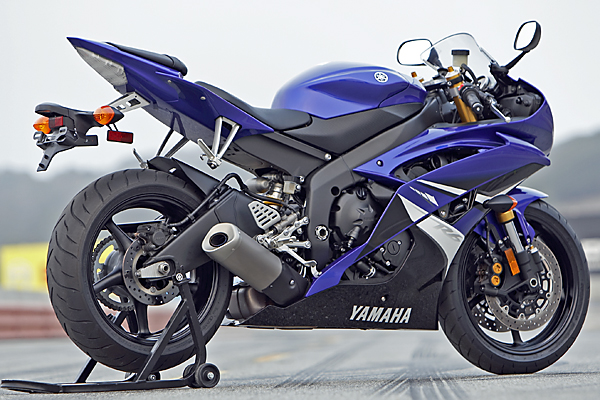
Courtesy of our friends at Solo Moto, and roughly 8 laps on the new R6 at Laguna Seca earlier this month, we have the following riding impression of Yamaha’s all-new supersport weapon. Solo Moto rode the bike in Sugo, Japan, while Dirck rode the bike briefly in Northern California (before tucking the front end in turn 11 coming onto the front straight of the famous Laguna Seca circuit).
We will not repeat our discussion of the technological changes to the new R6. That discussion took place here. This is our first riding impression.

Yamaha’s efforts to address our biggest concern with the old R6 have been a success, as far as we can tell after our initial rides on the new bike. Namely, the powerband is much broader, and much more usable in the mid-range. The old bike had a great top end, but relatively little power (relative to the competition, particularly Honda’s CBR) below 10,000 rpm. That has clearly changed thanks to significant engine changes, including but not limited to a bump in compression and the variable intake length system (YCC) first used on the R1 a year ago.
The last time I rode at Laguna Seca, I was aboard an open-class machine (the Buell 1125R). I expected the R6 to feel slow on this flowing, and fast, race track by comparison. It did not.
Leaving pit lane on two occasions, I purposely lugged the 600 below 5,000 rpm, and found much better throttle response than I remember from my testing of the old R6. Surprisingly, mid-range drive out of corners was enhanced without reducing top-end power.

If anything, top-end felt stronger on the new R6. Exiting the tight left-hand turn 11, which feeds onto the front straight, I rolled the throttle on in second gear and snapped it wide open once the bike was stood up. The R6 pulled strongly from roughly 7,000 rpm (for a 600, at least), and really leapt forward above 11,000 rpm, raising the front wheel despite having my ample weight planted over the gas tank.
In Sugo, Solo Moto’s test rider, Antoni Caballé had a similar impression of the new R6 engine. Smooth throttle response from as low as 6,000 rpm allows you to pick up the gas fairly early on corner exits, and set yourself up for an explosion of power above 11,000 rpm. The new R6 should be no slouch on the dyno, but it has already proven to us that it has competitive, and effective, power on a race track.
The ergonomics of the new R6 place significantly more weight over the front end. The seat is moved forward 5mm, and the bars are moved forward and down slightly (5mm in each direction). I could really feel the extra weight over the front end of the bike while I rode this R6 around Laguna Seca. In comparison to the Buell I last rode at this circuit (which has a decidedly upright riding position for a sportbike), the difference was rather dramatic, and would take some getting used to. Compared to the 600cc competition, I suspect the R6 will have one of the most radical, race oriented riding positions in the class.
The new chassis does reward the rider with nimbleness, and surefootedness. At Sugo, Caballé noticed the bike changed directions very easily, and quickly. Straight line stability was good, and the R6 was by no means “twitchy”.

Apparently, one Sugo corner exit is in first gear, which allowed Caballé to spin up the rear tire slightly. Under these circumstances, you get to know a lot about a chassis, and Caballé was impressed with his ability to control the bike under these circumstances. No panic, just an indication that the rear tire is protesting the amount of horsepower and torque received at such a low speed.
Both Caballé and I were impressed by the brakes, and Caballé noted no reduction in power or feel despite flogging the bike at Sugo for several laps (attributing the lack of fade, at least in part, to the increased thickness of the front rotors this year). Yamaha’s supersport brakes have typically been good, and the new R6 is no exception.
Yamaha’s YZF-R6 has a well deserved reputation for superb handling. The last version of this bike handled better than any of the competition, while providing that elusive, but all important, feedback from the tire patches up from the bike and into the rider’s body. This new 2008 YZF-R6 may actually handle better than the prior version (we want more time on the bike), but it is certainly not a step backwards in this department. Most significantly, the motor is now an effective compliment to the wonderful chassis.

We are planning another supersport comparison test this year, so stay tuned. If you want more information on the new, 2008 Yamaha YZF-R6, take a look at Yamaha’s web site here. As we stated in our preview article, U.S. MSRP is $9,599 for standard colors or $9,799 for the “Cadmium Yellow with Flame” paint job.





